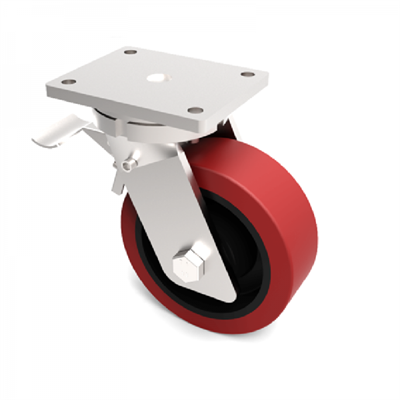The future of rigid caster technology is likely to see several advancements and innovations driven by changing industry demands, emerging technologies, and environmental considerations. While predicting the future is always speculative, here are some potential developments and trends in rigid caster technology:
- Smart Casters: Future rigid casters may incorporate sensors and IoT (Internet of Things) technology to provide data on caster performance, load monitoring, and maintenance needs. This data can be used for predictive maintenance and improved operational efficiency.
- Sustainable Materials: With an increased focus on sustainability and reducing the environmental impact of industrial processes, casters may be developed using eco-friendly materials and manufacturing techniques.
- Innovative Wheel Materials: Advanced materials for caster wheels, such as graphene, may be used to improve durability, reduce rolling resistance, and enhance load-bearing capabilities. These materials could also lead to quieter and smoother operation.
- Autonomous and Robotic Applications: Rigid casters could play a role in autonomous mobile robots and robotic systems, supporting applications in warehousing, healthcare, logistics, and manufacturing.
- Dynamic Load Management: Future casters may feature dynamic load management systems that can adjust the caster’s performance characteristics based on the load being carried, providing better stability and control.
- Noise Reduction Technologies: Ongoing research may lead to more effective noise-reduction technologies, further reducing the sound produced by caster wheels during operation.
- Customization and 3D Printing: Advances in 3D printing and manufacturing technologies may make it easier to produce custom-designed rigid casters tailored to specific applications.
- Energy Efficiency: Rigid casters could be designed to reduce the amount of energy required for rolling, potentially leading to energy-efficient and sustainable industrial operations.
- Anti-Static and ESD Control: In settings where electrostatic discharge (ESD) is a concern, casters may include anti-static features to prevent damage to sensitive electronic equipment.
- Improved Braking Systems: Rigid casters could feature advanced braking systems that provide more precise and reliable control, enhancing safety in various applications.
- Remote Control and Automation Integration: Casters may become part of larger automation and robotics systems, allowing for remote control, monitoring, and optimization of caster-equipped equipment.
- Advanced Materials for Challenging Environments: Rigid casters designed for extreme environments, such as high-temperature foundries or corrosive chemical facilities, may use advanced materials to withstand harsh conditions.
- Regulatory Compliance: Rigid caster technology may continue to evolve to meet or exceed industry-specific regulatory and safety standards.
The future of rigid caster technology is likely to be shaped by advancements in materials science, robotics, automation, and data analytics. As industries evolve and demand more efficient, sustainable, and reliable solutions, rigid casters will adapt to meet these evolving needs. Innovation in this area will continue to play a critical role in improving the safety, efficiency, and performance of equipment and material handling systems across various industries.


